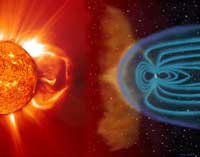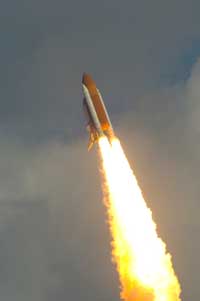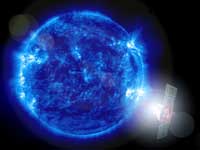Science teaching in space: the ESA teachers workshop Inspire article
Meet an astronaut, cook a comet and plan a trip to Mars. Shamim Hartevelt introduces a recent teacher workshop at ESA.

Space can be a great topic for capturing the imagination of school children – or indeed adults. It certainly inspired the 40 secondary-school science teachers wh were invited to the European Space Agency (ESAw1)’s technology centre in Noordwijk, the Netherlands, for a four-day workshop in July 2011.

a SOHO image of the Sun and
an artist’s impression of
Earth’s magnetosphere
Image courtesy of NASA
(magnetosphere) and ESA /
NASA – SOHO (the Sun)
Hands-on activities, lectures, presentations and a meeting with an astronaut – ESA’s second summer workshop for teachers was packed with action and ideas to use in the classroom and share with colleagues. The teachers learnt how to cook a comet, plan a trip to Mars, hunt for exoplanets and build bridges between art, science and language. They also looked at ESA’s Earth observation activities and were introduced to Europe’s fleet of Solar System and astronomy missions – all ready to be integrated into their science lessons.

lifts off from the Kennedy
Space Center in Florida, USA,
on 7 February 2008. On
board is ESA astronaut
Léopold Eyharts
Image courtesy of ESA /
S Corvaja
In some of the lively and engaging workshops, the participants learned about the many valuable resources provided by ESAw2. For example, the Eduspace websitew3, which provides secondary-school students and their teachers with learning and teaching tools about Earth observation. Or the archive of data from SOHO, the collaborative ESA-NASA project to study the Sun, from its deep core to the outer corona and the solar wind. During the workshop, the teachers learned how to use the archive tool to access over 14 years’ worth of SOHO dataw4.

km from Earth. There, it
constantly watches the Sun
for activity, returning
spectacular pictures and data
of the storms that rage
across its surface. SOHO was
launched in 1995 and was
designed to work for three
years. It is still working today
Image courtesy of ESA
The highlight for many was a close encounter with ESA astronaut Léopold Eyharts, who talked about living and working in space and described how ESA’s Columbus laboratory was delivered to the International Space Station (to learn more about Columbus, see Wegener, 2008).
Space may sound beyond the reach of most teachers, but the workshop was not. As one happy participant, Yves Carbonnier from France, put it, “The workshop was strongly directed toward real classrooms and real teachers: no expensive materials, no sophisticated apparatus, no high-level content useless for our daily work. I’m sure that my lessons will be influenced by this workshop.”
After four days, the participants left Noordwijk with their bags bulging with ESA education materials and resourcesw2 and their minds bursting with ideas and information to share with their colleagues back home.
European teachers will be invited to apply for the third workshop, taking place in Summer 2012. To be informed when the application is open, contact isseducationteam@esa.int, asking to be added to the mailing list. The workshop will also be advertised on the ESA website and in Science in School. Priority will be given to those who have not attended before and to teachers who are committed to sharing what they have learned with their colleagues.
References
- Wegener AL (2008) Laboratory in space: interview with Bernardo Patti. Science in School 8: 8-12. www.scienceinschool.org/2008/issue8/bernardopatti
Web References
- w1 – The European Space Agency (ESA) is Europe’s gateway to space, organising programmes to find out more about Earth, its immediate space environment, our Solar System and the Universe, as well as to co-operate in the human exploration of space, develop satellite-based technologies and services, and to promote European industries. See: www.esa.int
- ESA is a member of EIROforumw5, the publisher of Science in School.
- w2 – To browse, order or download a wealth of space-related education materials developed by ESA, visit: www.esa.int/educationmaterials
- w3 – The Eduspace website encourages teachers to use Earth observation data in their curriculum by providing ready-made projects. See: www.esa.int/eduspace
- w4 – To investigate the SOHO data archive for yourself, visit http://soho.esac.esa.int/data/archive
- w5 – To learn more about EIROforum, see: www.eiroforum.org
Resources
- To learn more about ESA’s space missions, see:
- Mignone C, Barnes R (2011) More than meets the eye: unravelling the cosmos at the highest energies. Science in School 21: 57-64. www.scienceinschool.org/2011/issue21/em





